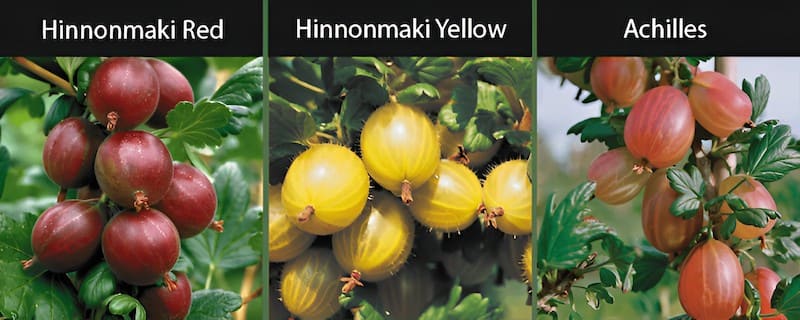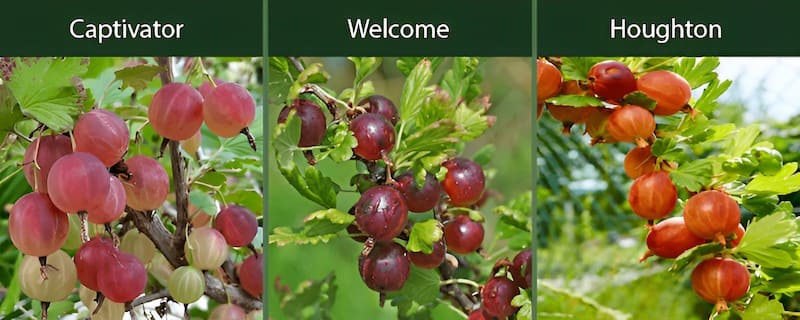
Much like other bush bearing berry plants such as currants and blackberries, gooseberries, beloved for their tart taste and versatility in culinary uses, offer an array of types and varieties worth exploring for any fruit gardening enthusiast. The Ribes genus, to which gooseberries belong, consists of two main types: the European Gooseberries (Ribes uva-crispa or Ribes grossularia) and the American Gooseberries (Ribes hirtellum).
European Gooseberries, native to Europe, are recognized for their distinctive, pronounced flavor and larger berry size. These berries sport a range of colors, including green, yellow, red, and even purple. Varieties such as 'Invicta', 'Greenfinch', 'Hinnonmaki Red', and 'Hinnonmaki Yellow' are often favored for their unique taste profiles and hardiness in cooler climates. Perfect for crafting jams, pies, and desserts, European gooseberries have a sweet-tart taste that brings a delightful complexity to any dish.
On the other hand, American Gooseberries, originating from the northeastern and north-central United States, offer a slightly milder flavor. They are typically smaller than European varieties but are nonetheless cherished for their taste and adaptability to various climates. Their fruit can range from green to pink or even red. Popular varieties include 'Pixwell', 'Welcome', and 'Poorman'. These berries are often selected for their notable disease resistance, making them a more low-maintenance choice for beginner gardeners or those seeking hardier plant options.
Both European and American Gooseberries have a charm of their own and choosing between them would mostly depend on your taste preference, climate, and gardening goals. Whether you prefer the bold flavors of the European types or the subtle, resilient American varieties, growing gooseberries can be a rewarding venture, providing a bountiful harvest of this unique fruit for your culinary endeavors.
European Gooseberries (Ribes uva-crispa or Ribes grossularia) are a variety of berry that originated in Europe and are known for their larger size and more pronounced flavor compared to other gooseberry types. The berries can be green, yellow, red, or even purple and are often used in jams, pies, and other desserts due to their unique sweet-tart taste.
Invicta: This variety is popular due to its resistance to American gooseberry mildew and produces heavy crops of large, pale green berries. The berries are excellent for both dessert and culinary use.
Hinnonmaki Red: Known for its resistance to mildew and other diseases, the Hinnonmaki Red produces red berries with a tart skin and sweet flesh.
Hinnonmaki Yellow: This variety, originating from Finland, yields plentiful crops of yellow-green berries that have a delicious, aromatic flavor.
Greenfinch: Greenfinch has mildew-resistant properties and produces heavy crops of medium-sized, yellow-green berries with a superb flavor.
Careless: This variety is a vigorous grower, producing abundant light-green berries that are resistant to mildew.
Leveller: This variety is known for large, yellow fruit with a sweet taste, excellent for dessert use.
Achilles: An older variety, 'Achilles' yields large, oval berries that are yellow-green and have a good, tart flavor.
Whitesmith: This early-season variety produces medium to large, sweet, pale green to yellow berries.

American Gooseberries (Ribes hirtellum) are a native variety to the northeastern and north-central United States, known for their slightly smaller size and milder flavor compared to their European counterparts. These berries can range in color from green to pink to red and are hardy plants often chosen for their disease resistance and adaptability to various climates.
Pixwell: Known for its mildew resistance and adaptability, Pixwell produces pink berries that are somewhat tart when eaten fresh but sweeten when cooked.
Welcome: Welcome gooseberries are large and sweet, with a red color. They're resistant to mildew and are good for both fresh eating and making preserves.
Poorman: An excellent choice for fresh eating, preserves, and baking, Poorman gooseberries are sweet and aromatic. They're resistant to powdery mildew and relatively easy to grow.
Captivator: This is a thornless variety of gooseberry that produces large, sweet, pinkish-red berries. Captivator is resistant to powdery mildew and leaf spot.
Oregon Champion: Known for being vigorous and productive, Oregon Champion yields large, light-green berries that are great for pies and preserves.
Downing: An heirloom variety, Downing produces pale green, medium-sized berries with a sweet, juicy flavor. It's resistant to powdery mildew and leaf spot.
Houghton: This is an old variety of gooseberry that's known for its resistance to diseases. Houghton berries are small to medium-sized and sweet, with a pinkish-red color.

Choosing between European, American, and hybrid gooseberries can depend on several factors like growing conditions, flavor preference, and disease resistance. Here are a few helpful hints to help you make the best choice:
1. Climate and Soil: American gooseberries (Ribes hirtellum) are more resistant to heat and drought than European gooseberries (Ribes uva-crispa). Therefore, if you live in a region with hot, dry summers, American gooseberries might be a better choice. European gooseberries prefer cool, moist climates. Both kinds prefer well-drained soil.
2. Disease Resistance: American gooseberries are generally more resistant to diseases such as white pine blister rust and mildew, both of which can be problematic for gooseberries. If disease resistance is a major concern for you, you may want to consider American or hybrid gooseberries.
3. Berry Size and Flavor: European gooseberries are usually larger and often sweeter than their American counterparts, which tend to be smaller and more tart. If you prefer larger, sweeter berries, European gooseberries might be the best choice. But if you like a tart, tangy flavor, you might prefer American gooseberries. Hybrids can offer a middle-ground in terms of size and sweetness.
4. Pruning and Maintenance: American gooseberries typically have a more spreading habit and may require more pruning to maintain a manageable size compared to European gooseberries.
5. Thorns: Both American and European gooseberries have thorns, but American ones are typically more thorny. This can make harvesting American gooseberries a bit more challenging.
6. Hybrids: Hybrid gooseberries (like those in the 'Jostaberry' variety) combine characteristics of both American and European varieties. They're often larger (like European varieties), with a more robust disease resistance (like American varieties). If you can't decide between European and American, a hybrid might be an optimal choice.